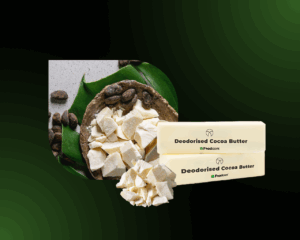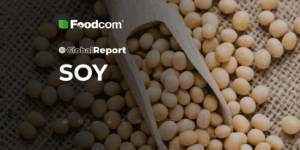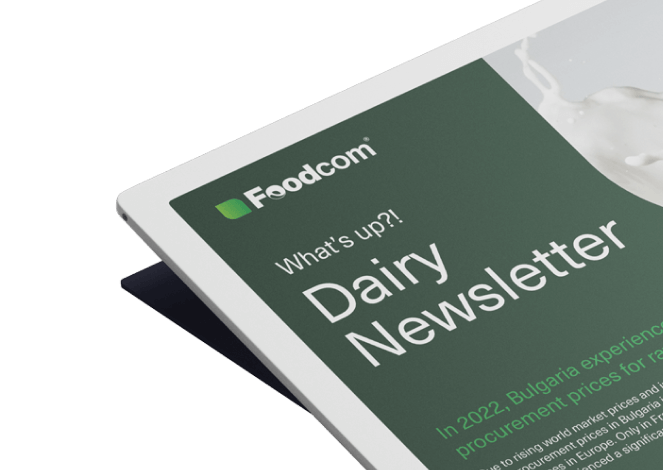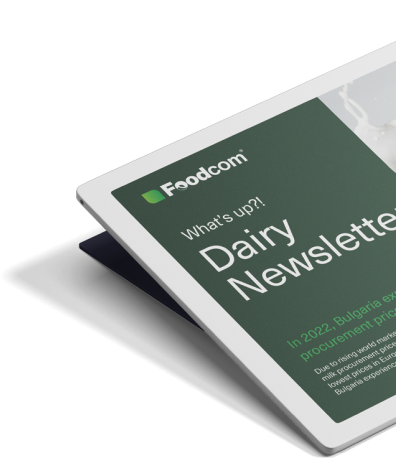- In September 2025, the agricultural commodities market was clearly diversified.
- Cereals and dairy products fell in price due to high supply, while coffee and cocoa rose in price due to difficult weather conditions.
- Cereal and dairy prices stabilised at low levels, improving the position of buyers.
- The coffee and cocoa segment remained highly volatile, increasing cost pressure in Europe.
- The additives market remained stable, although it was increasingly affected by rising energy and transport costs.
It was a month that saw clear differentiation between categories: milk and cereals cheapened under the influence of high supply, while coffee and cocoa reacted to weather problems in Brazil and West Africa. In the vegetable oil market, the pace of increases has slowed, but cost pressures in Europe persist, particularly due to rising transport costs and trade policy towards Malaysia.
For European buyers, September was a moment of brief respite, but also a sign that the fourth quarter may bring a renewed increase in cost tensions. Companies are increasingly combining price hedging strategies in high-risk categories (coffee, oils) with contract renegotiations where the market offers room for reductions.
Dairy products
September 2025 was another month of price falls for the European dairy market, although the pace of price falls has clearly slowed. According to FAO data, the price index for dairy products fell by 2.6% month-on-month, with downward pressure particularly on butter and skimmed milk powder(SMP). In Europe, quotations for these categories approached the levels of the beginning of the year, which in practice means a return to a relatively low price base.
The market also saw the effects of a seasonal increase in raw milk supply. Autumn came to the dairy market faster than usual, resulting in an increase in dairy stocks and additional pressure on milk fat prices. Butter prices in Western Europe fell by an average of 4-5 % m/m, while in Poland reductions of even more than 6 % were observed. Cheese and whole milk powder(WMP) remained stable, with slight fluctuations depending on the export direction.
The situation was also influenced by the global context: lower demand from China, which reduced milk powder imports, and weaker purchasing activity in the Middle East region. In the UK, on the other hand, feed problems and cases in cattle herds have reduced local raw milk production, which could affect trade relations in the EU in the longer term.
Read more: UK in feed crisis: botulism in cattle herds and wave of illegal meat imports.
For European processors, September was a moment to sort out balance sheets and analyse pricing strategies for Q4. The market remains cool, but not overvalued – meaning that the room for further declines may be shrinking. The pace of inventory consumption and export data from the EU will be key in the coming weeks. Companies planning long-term contracts may still benefit from a lower price base, but should consider flexible pricing formulas to react to a possible rebound in early 2026.
Cereals and starches
September 2025 was a month of continued supply pressures for the cereal market. The FAO Global Grain Price Index fell by 0.6% month-on-month to 105 points, continuing the downward trend observed since the spring. In European markets, wheat and maize quotations remained stable, but at low levels – below the 2024 averages.
On the MATIF exchange in Paris, consumer wheat contracts fluctuated between EUR 190-205/MT, with temporary dips below EUR 190/MT on increased export supply from Russia. In Poland and Central Europe, the price spread was wider, from around EUR 160 to 230/MT, depending on the quality of the grain and the region. Maize remained in the range of EUR 195-210/MT, supported by stable feed demand despite abundant crop forecasts in the US and Ukraine.
FAO and USDA forecasts indicate that global cereal production in 2025/26 could reach a record 2.97 billion tonnes. At the same time, falling maize and barley prices are putting pressure on feed manufacturers’ margins, but are beneficial for the livestock sector. For European importers and millers, this means lower raw material costs, but also increasing export competition from third countries.
In Canada, forecasts for 2025 indicate a decline in wheat production, which could limit the global supply of high-protein varieties and strengthen the position of EU exporters in the long term. In the EU countries, on the other hand, a stable starch campaign – in both wheat and potato – allowed prices to remain moderate.
September was therefore a period of relative calm for the cereal market, but also of increasing export competition. With continued high supply and limited import demand from North Africa, the market remains favourable to buyers. Food and feed companies in Europe should take advantage of this moment to renegotiate contracts and secure supplies ahead of potential logistical changes in the final quarter of the year.
Coffee and cocoa
September 2025 brought further nervousness in the coffee market and continued pressure on cocoa prices. Both commodities were in the spotlight for investors and importers as weather and geopolitical conditions most strongly influenced quotations in these segments.
In Brazil, a prolonged drought reduced forecasts for the arabica harvest, which translated into another month of price increases. On the ICE exchange, arabica futures rose by around 8-10 % month-on-month in the second half of September, reaching levels above US¢240/lb, while robusta futures rose by around 6 % to US¢125/lb. The market reacted not only to weather conditions, but also to concerns about logistics inside Brazil and tensions around exports through the Santos ports. Rising coffee prices are not only due to a smaller harvest, but also to increased activity by speculative funds, which amplify price volatility.
In Europe, this has meant an increase in the cost of green beans and pressure on roasters’ margins. Importers have had to reckon with rising freight prices and continued exchange rate uncertainty, particularly in the USD/EUR relationship. For the retail segment, this means that there is a risk of further coffee price increases in the fourth quarter, although some large chains have already secured volumes at earlier prices.
The situation in the cocoa market remained equally tense. After earlier increases, prices on the ICE exchange remained within a narrow trading range, still near historically high levels above USD 10 000/MT. The market remained influenced by limited supply from West Africa – particularly Côte d’Ivoire and Ghana – where weather conditions and cocoa tree diseases continued to affect production. Rising transport costs and continuing tensions in global supply chains remained additional risk factors.
For the European cocoa sector, September was a month of intensive search for alternative sources of supply and renegotiation of contracts. Quotations remained high but relatively stable, allowing some importers to plan their purchases more calmly. However, raw material costs still remain significant and confectionery manufacturers are increasingly passing on some of the cost burden to retail prices.
Both coffee and cocoa therefore remain the segments with the highest price volatility. Their further development will largely depend on weather conditions in South America and Africa, as well as trade decisions by the United States and the European Union on tariffs and subsidies. For importers in Europe, this means maintaining flexible purchasing strategies and hedging exchange rates until at least the end of the year.
Additions
September 2025 in the additives market was marked by moderate stability, but with increasingly clear signals of imminent cost changes. Most of the key components – such as citric acid, amino acids or feed vitamins – remained in similar price ranges to August, but rising energy and transport costs began to be increasingly felt in the offers of non-EU producers.
In China, citric acid prices remained stable, in the range of RMB 4 800-5 000/MT. Continued high stocks and weak export demand favoured buyers, allowing for price renegotiations and extended delivery times. Chinese producers have started to signal possible production cuts in Q4 due to rising electricity and gas prices, which may soon reverse the downward trend.
In India and South-East Asia, rising energy costs are already starting to affect the prices of some amino acids and vitamins. In Europe, meanwhile, the market remained relatively quiet, with suppliers focusing on maintaining stable customer relationships and replenishing stocks after the holiday season. At the same time, there was growing interest in alternative import destinations, including South America, which could become an important part of supply chain diversification in 2026.
After a summer of declining freight rates, September brought the first signs of a rebound, especially in directions from Asia to Europe. For importers, this means the need for greater flexibility in planning deliveries and securing cargo space in advance.
The additive market therefore remains stable, but potentially vulnerable. In the coming months, the main price drivers will be energy costs, freight and customs policy – especially if the European Union decides to revise import rates for selected chemical categories. For European buyers, this is the moment to diversify import destinations and negotiate longer contracts with energy clauses.
Summary and forecasts
September 2025 brought calm to the agricultural commodity market. Cereal and dairy prices remained low, favouring buyers, while the coffee and cocoa segments remained at high but stable levels.
For European importers, it is a period of relative equilibrium before the end of the year – with room to renegotiate contracts in stable sectors and the need to cautiously hedge volumes in riskier categories. In the coming months, the direction of the market will be determined by weather factors, the logistics situation and the pace of demand recovery in Asia.
![Monthly review of the agricultural commodities market [September] Monthly review of the agricultural commodities market [September]](https://foodcom.pl/wp-content/uploads/2025/10/Monthly-Agro-Commodities-Market-Overview-min.png)


![Miesięczny przegląd rynku surowców rolnych [Sierpień] Miesięczny przegląd rynku surowców rolnych [Sierpień]](https://foodcom.pl/wp-content/uploads/2025/09/monthly-agro-commodities-august-300x153.png)
![Miesięczny przegląd rynku surowców rolnych [Lipiec] Miesięczny przegląd rynku surowców rolnych [Lipiec]](https://foodcom.pl/wp-content/uploads/2025/08/monthly-agro-commodities-market-overview-300x153.png)



